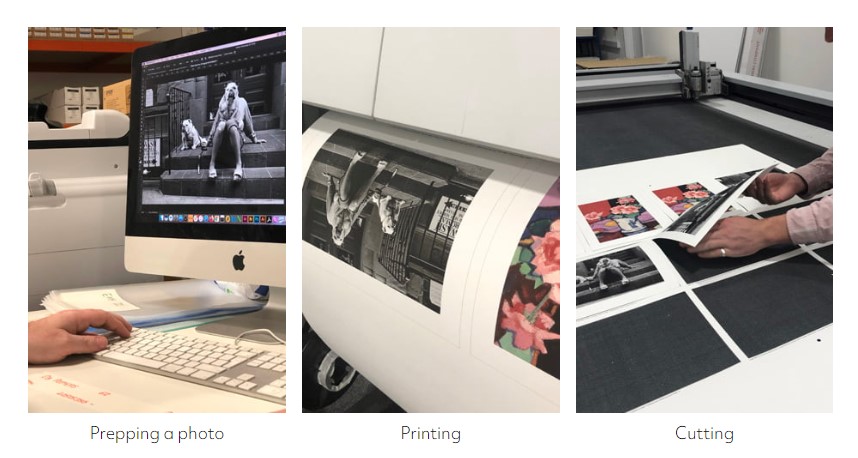what-is-giclee-fine-art-printing?
December 31 2023


The Art and Science of Giclee Printing
Printing.coop • PrintzBlitz.com
This article delves into the world of Giclee printing, a sophisticated inkjet printing method that has revolutionized the art and photography industries. We will explore its history, the technology behind it, its applications in various fields, the comparison with traditional printing methods, and the future of Giclee printing. This comprehensive guide aims to provide a deep understanding of Giclee printing for artists, photographers, and print enthusiasts.
History of Giclee Printing
The journey of Giclee printing begins in the late 20th century, marking a significant milestone in the world of fine art reproduction. The term 'Giclee,' derived from the French verb 'gicler' meaning 'to spray or squirt,' aptly describes the inkjet printing process used in this technique. Initially developed as a digital method to produce fine art prints, Giclee quickly gained popularity among artists and photographers for its ability to accurately replicate the nuances of original artworks.
The evolution of Giclee printing is closely tied to advancements in digital technology, particularly in the realms of inkjet printers and color management. Early Giclee printers were limited in color range and resolution, but as technology progressed, these printers became capable of producing images with extraordinary detail and a wide spectrum of colors. This advancement was crucial in bridging the gap between original artwork and reproductions, making Giclee prints virtually indistinguishable from the originals.
Giclee printing's rise irn popularity also coincided with the digital revolution in photography and art. Artists and photographers found in Giclee a tool that allowed for greater control over the final output, enabling them to produce works that were true to their original vision. The method also opened up new possibilities for limited edition prints, offering a high-quality, yet cost-effective solution for reproducing artworks.
Today, Giclee printing is revered in the art world for its fidelity and durability. It is a preferred choice for galleries, museums, and collectors who seek the highest quality reproductions. The history of Giclee printing is not just a tale of technological advancement but also a story of how innovation can redefine artistic expression and accessibility.
Understanding the Technology Behind Giclee Printing
Giclee printing stands out in the digital printing world due to its unique combination of precision, quality, and versatility. At the heart of this technology are high-end inkjet printers, which are significantly different from standard desktop printers. These specialized printers use small spraying devices that can accurately place incredibly tiny droplets of ink onto a variety o·f substrates.
The inks used in Giclee printing are another critical component. Unlike traditional inkjet inks, Giclee inks are typically pigment-based, providing superior color range, depth, and longevity. These inks are resistant to fading and can maintain their vibrancy for up to a century under optimal conditions. The color gamut of Giclee printing is notably broader than that of conventional printing, allowing for more accurate reproduction of the original artwork's colors.
Substrates in Giclee printing also play a vital role. A wide range of materials can be used, including archival quality papers, canvas, and even fabrics. The choice of substrate greatly influences the final appearance of the print, with each material offering its unique texture and finish. Archival quality papers, for instance, provide a matte finish and are preferred for prints where detail and color accuracy are paramount.
Another aspect of Giclee printing technology is the software and color management systems used. These systems ensure that the colors produced by the printer match the original artwork as closely as possible. Advanced color profiling and calibration are essential for achieving consistent and accurate results.
In summary, the technology behind Giclee printing is a sophisticated blend of hardware, consumables, and software. It's this combination that enables artists and photographers to reproduce their works with an unprecedented level of detail, color fidelity, and longevity, making Giclee printing a preferred choice for high-quality art reproductions.
Giclee vs. Traditional Printing Methods
The comparison between Giclee and traditional printing methods reveals significant differences in quality, durability, and applications, making Giclee a distinct and often preferred choice in many scenarios.
Quality is one of the rmost notable differences. Giclee printing, with its advanced inkjet technology, offers a level of detail and color accuracy that surpasses most traditional printing methods. The use of pigment-based inks in Giclee printing contributes to a broader color gamut and deeper color saturation, resulting in prints that are more vivid and closer to the original artwork. Traditional methods, while effective in their own right, often fall short in replicating the subtleties of color and texture present in original artworks.
Durability is another key factor where Giclee printing excels. Giclee prints, when created on archival quality substrates with pigment-based inks, can last for decades without significant fading or color
degradation. This long1evity is crucial for art collectors, galleries, and museums, as it ensures the preservation of artworks over time. Traditional printing methods, particularly those using dye-based
inks, are more susceptible to fading and environmental damage.
In terms of applications, Giclee printing is highly versatile, accommodating a wide range of substrates and sizes. This flexibility makes it ideal for fine art reproductions. photography, and even large-scale artworks. Traditional printing methods, such as lithography, screen printing, and offset printing, have their unique advantages and are preferred for certain types of projects, especially those requiring large print runs.
In summary, while traditional printing methods continue to be valuable for specific applications, Giclee printing stands out for its superior quality, durability, and versatility. Its ability to produce highfidelity reproductions has made it a favorite among artists, photographers, and collectors, and it continues to shape the landscape of art and photographic reproduction.
The Future of Giclee Printing
The future of Giclee printing is poised for exciting developments, driven by technological advancements and evolving market demands. As we look ahead, several trends and potential innovations stand out, promising to further enhance the capabilities and applications of Giclee printing.
One of the key areas of development is likely to be in the realm of printer technology. Future Giclee printers may offer even higher resolutions and faster printing speeds, without compromising on quality. Advancements in ink technology are also anticipated, with the potential for new ink formulations that provide even greater color accuracy, longevity, and environmental sustainability.
Another area of growth could be in the integration of Giclee printing with emerging technologies such as augmented reality (AR) and virtual reality (VR). This integration could open up new avenues for interactive art and exhibitions, where viewers can engage with Giclee prints in immersive and dynamic ways.
The market for Giclee printing is also likely to expand, with increasing demand from various sectors including interior design, fashion, and advertising. These industries are recognizing the value of highquality, customizable prints that Giclee technology offers.
Furthermore, as the awareness of environmental sustainability grows, Giclee printing could see a shift towards more eco-friendly practices. This might include the use of recycled materials for substrates and the development of inks that are less harmful to the environment.
In conclusion, the future of Giclee printing looks bright, with potential advancements in technology and expanding market opportunities. These developments will not only benefit artists and photographers but will also enhance the way we experience and interact with printed images. As Giclee printing continues to evolve, it will undoubtedly maintain its status as a key player in the world of high-quality art and photographic reproduction.